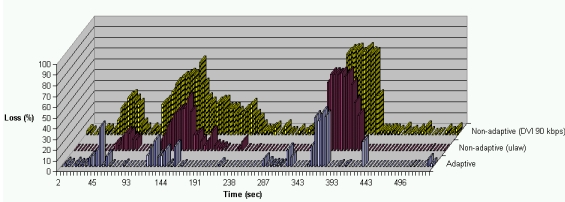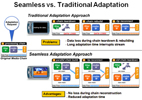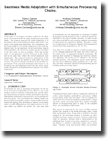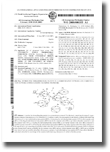| |
| | |
|
|
Seamless Media Adaptation
How to adjust media qualities to the context?
|
| | |
 Ubiquitous Computing Ubiquitous Computing
 Ubiquitous Media Ubiquitous Media
 Hybrary - Hybrid Library Hybrary - Hybrid Library
 Museum Technology Museum Technology
 Pervasive Gaming Pervasive Gaming
 Color Quantization Color Quantization
 Image Compression Image Compression
 Quality of Service Quality of Service
 Intelligent Internet Services Intelligent Internet Services
Seamless Media Adaptation
 Supervised Theses Supervised Theses

|
In future multimedia communication scenarios, different aspects of heterogeneity will pose several
technical challenges for transmission technologies. Typical applications will serve large groups of
users with particular Quality-of-Service (QoS) wishes, utilizing a broad range of heterogeneous
multimedia devices connected via different (and probably in most cases wireless) access network technologies.
In order to save bandwidth, maximize subjective perceived quality and allow for simple and secure
implementations of network nodes, efficient adaptive media transport mechanisms will become necessary.
The following projects have been realized at the
 NEC Heidelberg Research Lab.
NEC Heidelberg Research Lab.
The projects have been published at International Conferences and Journals.
|
| | |



|
MediaStorm
How to create adaptive media support for applications?
Adaptation can be performed at various places. At the application layer, specific requirements are
well-known, but the mechanisms have to be 're-invented' for every application again and also
interoperability is not ensured. Adaptive operating systems have a global view on the nodes resource
situation and could allows for optimized utilization and fairness, but the application semantic
is not known. Also, operability between different operating systems is hard to achieve.
MediaStorm is an adaptive middleware layer between applications and operating systems,
which can combine both advantages. This allows for an efficient and fair handling of all involved
media streams according to the overall resource situations.
MediaStorm is a Java-based multimedia streaming library, which abstracts from the underlying multimedia
system (e.g. Apple Quicktime, Sun Java Media Framework for J2SE, Sun Java MMAPI for J2ME, etc.)
and operating system. Easy interfaces allow for a simplified development of feature-rich adaptive
multimedia applications (like video-on-demand, IP-telephony, Internet Radio, and many more).
MediaStorm can be installed on any node of the transmission scheme and is able to automatically
perform seamless media adaptation mechanisms. The MediaStorm approach was instantiated by the adaptive
media projects following below (AdaptiveStreaming, SeamlessCodecSwitching).
|
| | |




|
Adaptive Streaming
How to adapt audio/video quality during streaming?
In these projects, end-to-end adaptation of media streams are realized by introducing
syntactical and semantical filters, which can operate at the sender, in inner network nodes of the
transmission chain, and at the receiver side.
In a diploma thesis project together with the University of Applied Sciences in Mannheim,
we developed a new Java native interface for the Sun Java Media Framework (JMF) to support real-time
video filtering and compression attribute adaptation using a DivX-based MPEG-4 codec.
By using a complex adaptation algorithm, we were able to control the intra-frame quality and the
actual frame rate of an MPEG-4 stream during the transmission to adapt to the current network situation
(indicated by loss and jitter values). By using a network simulator, the performance of the algorithm
for different load situations was tested succesfully. In order to add further support for network handoff
situations we included a pre-handoff adaptation strategy, improving the results even further.
In a second thesis project with the University of Applied Sciences in Mannheim, we developed
JMF RTP packetizer, depacketizer and filter modules for the WaveVideo codec developed at the ETH Zurich.
This allowed us to test the impact of different filters (e.g. quality, data rate, frame rate)
on the quality of wavelet coded video material. The system allows for multicast streaming and enables
automatic sender datarate adaptation based on receiver feedbacks.
In a third thesis project in cooperation with the University of Stuttgart we analyzed the perceived
quality of different audio codecs (e.g. DVI, uLaw, G.723, GSM, MP-3, etc.).
The human ear is especially sensitive to loss in audio data.
Therefore, we developed an adaptation strategy, which is able to reduce loss significantly by switching
to the most appropriate codec regarding the current transmission characteristics.
Details about the adaptive streaming approaches can be found in:
|
| | |


|
Andreas Kassler, Christian Kücherer and Andreas Schrader:
Efficient Wavelet Video Filtering
QofIS'2001, 2nd International Workshop on Quality of future Internet Services, Coimbra, Portugal, September 24-26th, 2001.
 Abstract and Paper at Springer Verlag, Abstract and Paper at Springer Verlag,
 Slides Slides
|
| | |

|
Christian Kücherer, Andreas Kassler, Andreas Schrader and Oliver Haase:
End Device and Network Adaptation of WaveVideo Streams
Proceedings of the SSGRR'2001, International Conference on Advances in Infrastructure for Electronic Business, Science, and Education on the Internet
L'Aquila, Italy, August 6-12, 2001.
 Abstract, Abstract,
 Slides Slides
|
| | |
|
|
See also:
Christian Kücherer:
Quality of Service with Adaptive Video Coding
Diplomarbeit, 2001, University of Applied Sciences Mannheim.
Philipp Bostan:
Adaptive Video Transmission For Heterogeneous Networks
Diplomarbeit, 2002, University of Applied Sciences Mannheim.
Hyung-Woo Kim:
Design and implementation of an adaptation algorithm for audio streaming applications.
Diplomarbeit, 2001, University Stuttgart.
|
| | |


|
SeamlessCodecSwitching
How to realize seamless adaptation?
A media processing chain is often a complicated collection of codecs, packet handlers, media filters,
and memory buffers for processing media data. Adapting such a media processing chain often requires
a lengthy process of deconstructing parts of chain or the complete chain, and rebuilding a replacement.
This process is impacted by two types of delay, present within every element of the media processing chain
- setup delay and intrinsic delay. Setup delay is defined as the time required by the processing element
to initialise its internal data structures, acquire necessary resources and become ready for operation.
Intrinsic delay is characterised as the additional time, beyond setup delay, required by a processing
element to produce a particular output with a given input. Together, setup and intrinsic delays can
introduce additional levels of data loss and extended delays that can degrade quality.
Conventional adaptation mechanisms utilize a simplified method of deconstructing and reconstructing
media processing chains without regard for either setup or intrinsic delays. Since these delays can be
significant and cause data loss, we developed a new seamless method that avoids these effects.
By using simultaneous processing chains instead of sequential teardown and setup phases, the adaptation
process has been significantly improved. We proved our system with an analytical model and also build a
Java-based prototype implementation. Switching between video codecs for example can be realized with a
gap time below 1ms and no loss at all.
|
| | |


|
Details about the Seamless Codec Switching method can be found in:
Darren Carlson and Andreas Schrader:
Seamless Media Adaptation using simultaneous Media Processing Chains
ACM Multimedia 2002
( ACM MM'2002),
Juan les Pins, France, December 1-6th, 2002. ACM MM'2002),
Juan les Pins, France, December 1-6th, 2002.
 Short Paper, Short Paper,
 Poster Poster
|
| | |

|
The Seamless Codec Switching mechanism was patented in Germany, the U.S. and Japan.
See ( publication)
section for details. publication)
section for details.
|
|
|
|